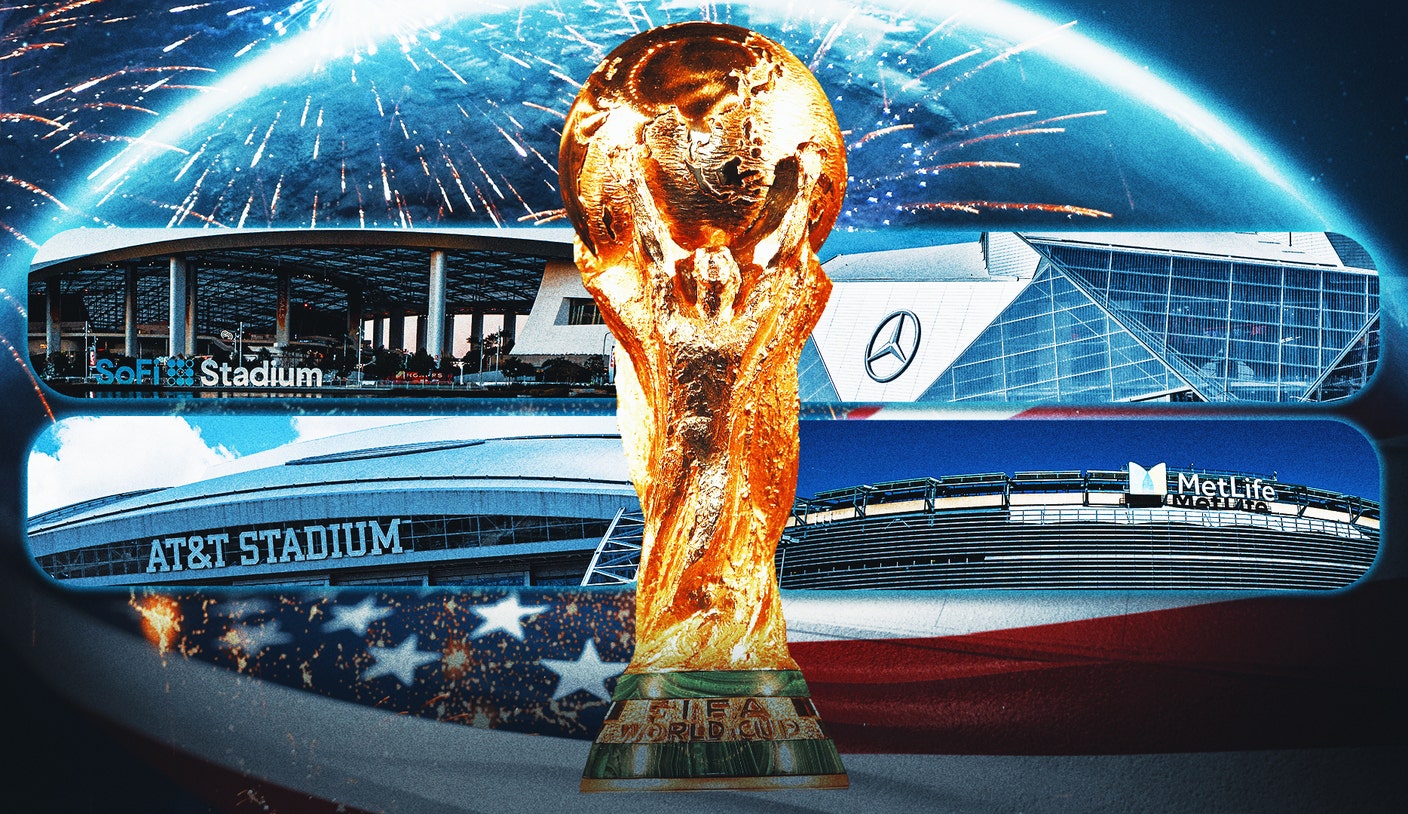Doug McIntyre
Soccer Journalist
It may not feel like it just yet, but there’s a party like never before happening next year. And it’s been building since 1994.
Except this bash is being compared to having “104 Super Bowls in one month.”
Having covered soccer for two decades and at five World Cups across the globe, I’ve seen some of soccer’s biggest moments — from Lionel Messi’s glory in 2022 (and his years of agony before that) to Tim Howard’s record 15-save performance for the U.S. men’s national team at the 2014 edition in Brazil.

Lionel Messi won his first World Cup at Qatar 2022. Could he win his second in the United States next summer? (Photo by Jabin Botsford/The Washington Post via Getty Images)
It all culminates in 2026, when the most popular spectacle in sports comes back to the United States as a 48-team behemoth, a 50-percent increase in size from any previous edition that will see the tournament span across our borders into Canada and Mexico as well.
When all’s said and done, the World Cup 2026 will be the largest event in history — sporting or otherwise. Its success will rest on the shoulders of some of the most passionate fans in the game.
But to pull it off, it’ll take expertise from the people from behind the scenes, most of whom aren’t household names. Here’s what they have to say about how they’ll do it.

As a proud son of Augusta, Georgia, U.S. Soccer CEO JT Batson knows exactly how to explain to folks back in his home state just how enormous the 2026 FIFA World Cup will be when the planet’s most popular event lands in Atlanta and 15 other North American cities starting next June 11.
“Depending on where you are, you try to contextualize so it’s something people can wrap their head around,” Batson told me earlier this month at an event with the governors of New York and New Jersey marking the one-year countdown to the World Cup.
“So when I’m down south it’s like, Atlanta is going to host a bigger version of eight straight SEC championships. They know how that overtakes the city, or how Ohio State-Michigan, just swarms Columbus.”

The FIFA World Cup trophy is displayed on the field of the Mercedes-Benz Stadium in Atlanta, Georgia. (Photo by Stew Milne/FIFA via Getty Images)
Others have taken a similar approach.
“The Super Bowl, which is fantastic, has what, 120-130 million viewers? The World Cup has six billion,” FIFA president Gianni Infantino said in an interview with FOX Sports in April. “A World Cup is 104 Super Bowls in one month.”
FIFA vice president Victor Montagliani took things even further. The Canadian businessman is also the president of CONCACAF, the governing body that represents the soccer associations in North America, Central America, and the Caribbean.
“I’ll disagree with my FIFA president on one thing,” Montagliani said in a phone interview. “Once we get out of the group stage, into the round of 32 and the round of 16 — forget about the final — it’s already way bigger than the Super Bowl.”
Most Americans now know that the World Cup is a colossus and has been for more than half a century, when the advent of live television turned it into the most watched sporting event on earth. The 2022 final, in which Lionel Messi led Argentina past Kylian Mbappé and France, drew 1.42 billion viewers globally, the most-ever, including 26 million stateside on an NFL Sunday.
Entire counties come to a standstill when their national teams play. In 2018, Mexican fans celebrating El Tri’s upset of defending champion Germany triggered a small artificial earthquake caused by mass jumping during Mexico’s goal in the World Cup. El Salvador and Honduras once fought a six-day war following a series of World Cup qualifying games.
The signature quadrennial event will grow even larger for 2026 World Cup, which will be the first to involve 48 teams — a 50-percent increase from Qatar 2022 — as well as the first to be staged in three host nations. This World Cup, in other words, will be the granddaddy of them all.
“It’s going to be the biggest sporting event in the history of the world,” U.S. men’s national team legend Landon Donovan told reporters in June. “When all is said and done, this has the potential to be the biggest event in history,” added Alexi Lalas, Donovan’s fellow USMNT great turned FOX Sports analyst.
In this age of immediacy, the 2026 World Cup still seems distant even to die-hard soccer fans 12 months out. But when it lands on these shores next June, the US public won’t know what hit them.
“We love big events in this country,” FOX Sports Tom Rinaldi told me. “Millions of Americans watch one football game the entire year. The Super Bowl is as much a cultural event as it is a sporting event. The World Cup absolutely fits that same shape. It’s a cultural phenomenon.
“And there’s a momentum and a passion that comes with the World Cup,” Rinaldi added. “The Super Bowl, as great as it is, is one day. This has an opportunity to build, where word of mouth spreads, where proof of the passion and concept spreads, where there are dramatic comebacks and storylines that develop.
The only other time the men’s World Cup came to the U.S., in 1994, it shattered attendance records that stand to this day. That 24-team, 52-game tournament was played in nine stadiums and drew 3.6 million fans in total and an average of 69,174. The closest any World Cup since got to those figures was Brazil 2014, which hosted 3.43 million ticket buyers across 14 more matches, or 53,592 on average.

The 1994 FIFA World Cup final, held at the Rose Bowl in Pasadena, had an attendance of over 94K. (Photo by Mark Leech/Offside via Getty Images)
The 2026 World Cup will have 104 matches — 40 more than 2022 and twice as many as in 1994. “Nobody really knows what’s coming and how big this is going to be — even among those in the business I would call football people,” Montagliani said. “This has never been done before.”
Consider where the sport was in America three decades ago, when top-level soccer was a curiosity at best and, at worst, downright hated by millions of mainstream Americans. “There was no respect for the game at all,” Peter Vermes, who captained the USMNT at the 1990 World Cup, its first appearance following a 40-year absence, once said of that time.
There was no domestic league in the U.S. in 1994; MLS is now in its 30th season, with 27 teams in the U.S. and three more in Canada. Lionel Messi, the greatest player of all time, is in his third season with Inter Miami.
Three decades ago, there was next to no soccer on television or other media. These days, Americans can watch just about any game from any league anywhere on earth. Barcelona and Real Madrid jerseys dominate elementary school playgrounds in cities and suburbs alike.
In the New York City borough of Queens, basketball courts that stood for generations have been replaced by futsal ones that, on evenings and weekends, are packed.
The NFL is still king in America, but soccer is gaining more of a market share every year. Hosting the World Cup will only speed up that progress.
“I’d be shocked if we don’t get pretty close to, or even north of, five million,” Montagliani told me when asked about how many tickets could be sold for 2026.

Make no mistake: Stadiums will be sold out from coast to coast here and north and south of the border. In the U.S. alone, the 2026 World Cup is projected to drive almost $50 billion in economic activity, including more than $8 billion in social benefits and the creation of nearly 824,000 full-time equivalent jobs globally, according to FIFA.
All three governments are working closely together behind the scenes, as are their respective soccer federations.
In March, the White House convened a task force to ensure that the tournament is a success. It’s only the third time that’s happened for a sporting event and the first for a World Cup; President Clinton had a task force ahead of the 1996 Atlanta Olympics, as his successor, George W. Bush, did for the Salt Lake City games six years later.
“It’s great that senior officials in the White House, including the President, were engaged in this,” Montagliani said. Lalas, who attended a task force event in Washington, D.C. last month, said visitors will be made to feel more than welcome.
“I think from an organizational standpoint, we will make sure that whether it’s people traveling from the outside or people here on the inside, that they have a kick-ass experience — one that’s memorable, one that’s safe and one that they can take home with them,” said Lalas.
“We’re going to get a lot of international visitors,” said Monica Paul, executive director of the Dallas Sports Commission. AT&T Stadium in suburban Arlington will host nine matches next summer, more than any other venue.”But then there are locals as well, and so many people who may not even have a ticket or have the opportunity to see a World Cup game, but they just want to be a part of the action.”

AT&T Stadium, the home of the Dallas Cowboys, seats 80,000 people. (Photo by Omar Vega/FIFA via Getty Images)
Paul’s group will also organize a fan fest through the competition, as will all the other host cities plus many, like Chicago and Washington, that don’t have any matches at all. She’s expecting up to 100,000 people per day in Arlington. Dallas will also serve as home to the international broadcast center next summer, the same as in 1994.
“Not only are we looking at fans,” Paul said. “We’ll have thousands of broadcasters from all around the world working 24/7” at the IBC.
Additionally, the 48 teams will choose from more than 60 locations that have been identified by FIFA as potential base camps. There are 84 training sites and 178 practice fields in all. Add it up, and the next World Cup’s footprint will stretch across most of the continent, leaving a legacy in its wake.
“This is going to be a cultural revolution for the game, particularly in the U.S. and Canada,” Montagliani said. “Everybody wants to come here. Everybody wants to play here…I think we’ll see the benefits on our shores for decades to come.”
“When it comes to scale, the hype is real,” Rinaldi said. “This event is going to captivate the country in a way that will vastly exceed hardcore soccer fans. People will get swept up in the cultural phenomenon that is the World Cup.”
Doug McIntyre is a soccer reporter for FOX Sports who has covered United States men’s and women’s national teams at FIFA World Cups on five continents. Follow him @ByDougMcIntyre.

Get more from FIFA Men’s World Cup Follow your favorites to get information about games, news and more



